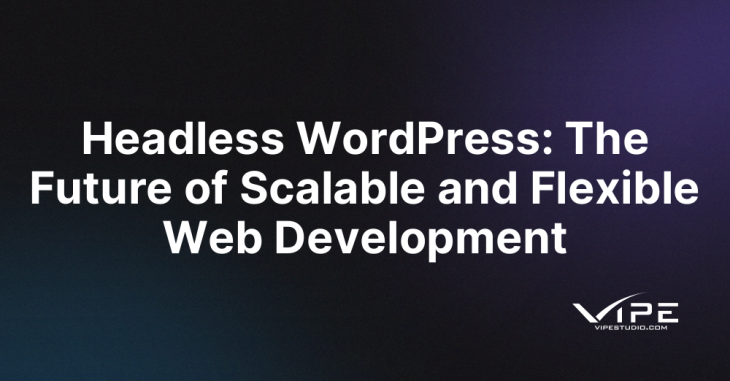Headless WordPress: The Future of Scalable and Flexible Web Development

READING TIME: MIN
As digital experiences evolve, businesses require more flexible and scalable solutions for web development. One of the most innovative approaches gaining traction is Headless WordPress. This modern architecture decouples the frontend and backend, providing businesses with greater customization, performance, and scalability. In this article, we will explore the benefits of Headless WordPress, its key use cases, and why enterprises are adopting this approach for their digital transformation.
What is Headless WordPress and How Does It Work?
Headless WordPress refers to a setup where the WordPress backend (used for content management) is separated from the frontend (used for content presentation). Instead of using the default WordPress themes and templates, Headless WordPress delivers content through APIs, allowing developers to use modern frontend frameworks such as Next.js, React, or Vue.js.
This decoupling enables businesses to build highly customized, fast, and interactive websites without being constrained by traditional WordPress themes and limitations. The REST API and GraphQL are commonly used to fetch and display content dynamically on different platforms, including websites, mobile apps, and IoT devices.

The Key Benefits of Headless WordPress for Enterprises
Switching to a Headless WordPress architecture provides significant advantages for enterprises that require high performance, flexibility, and scalability. Here are some of the key benefits:
1. Enhanced Performance and Faster Load Times
Traditional WordPress sites often rely on heavy themes and plugins, which can slow down performance. With Headless WordPress, the frontend is built using lightweight frameworks like Next.js, which optimizes page speed by using static site generation (SSG) and server-side rendering (SSR). This results in faster loading times and an improved user experience.
2. Omnichannel Content Distribution
Headless WordPress allows content to be distributed across multiple platforms beyond just a website. Businesses can publish content to mobile apps, smart devices, and even digital billboards using a single backend. This is particularly beneficial for enterprises that operate across multiple digital touchpoints.

3. Greater Flexibility in Design and Development
By decoupling the frontend from the backend, developers have complete control over how content is presented. They can build highly customized user interfaces using modern JavaScript frameworks without being restricted by WordPress themes. This flexibility enables businesses to create unique and engaging digital experiences.
4. Improved Security and Stability
Since the WordPress backend is only used for content management and is not exposed to the public, Headless WordPress reduces the risk of security vulnerabilities. Traditional WordPress sites often face threats from plugin vulnerabilities and brute force attacks, but with a headless approach, these risks are significantly minimized.
5. Scalability for High-Traffic Websites
Enterprises that handle large amounts of traffic need a scalable solution. Headless WordPress allows developers to use a content delivery network (CDN) and static site generation techniques to serve content efficiently. This ensures high availability and optimal performance, even during traffic spikes.

Use Cases: When Should You Choose Headless WordPress?
Headless WordPress is not the right solution for every website, but it offers significant advantages for specific use cases. Here are some situations where Headless WordPress is a game-changer:
1. Large-Scale Enterprise Websites
Enterprises managing complex websites with high traffic and multiple integrations benefit from the flexibility and performance of Headless WordPress. It allows seamless API integration with CRM systems, e-commerce platforms, and other third-party tools.
2. Multi-Platform Content Distribution
Businesses that need to publish content across websites, mobile apps, and IoT devices can leverage Headless WordPress to manage content centrally while delivering it to different platforms through APIs.

3. E-Commerce Websites with Custom Frontends
For e-commerce businesses that want a high-performance storefront, Headless WordPress can be combined with WooCommerce or other e-commerce solutions. This enables a fully customized shopping experience with fast-loading product pages.
4. News and Media Portals
News websites that require real-time content updates and fast performance can benefit from Headless WordPress. The decoupled architecture allows for instant content updates and efficient content delivery through CDNs.
How to Get Started with Headless WordPress
Adopting Headless WordPress requires careful planning and implementation. Here are the essential steps to get started:

1. Choose the Right Tech Stack
Since the frontend is separate from WordPress, you need to decide which framework to use. Popular choices include Next.js for React-based frontends or Nuxt.js for Vue-based applications. These frameworks offer server-side rendering and static generation for optimal performance.
2. Set Up the WordPress Backend
Install and configure WordPress as a headless CMS. You’ll need to enable the REST API or GraphQL to allow frontend applications to fetch content dynamically.
3. Develop a Custom Frontend
Build a custom frontend that fetches content from the WordPress backend. Ensure it is optimized for speed and responsive design to provide the best user experience.

4. Integrate a Content Delivery Network (CDN)
Use a CDN to serve static assets and cached content for improved performance. This reduces server load and speeds up content delivery to users worldwide.
5. Optimize for SEO and Performance
Even with Headless WordPress, SEO is critical. Implement best practices such as structured data, meta tags, and optimized images to ensure your website ranks well in search engines.
Why Choose Vipe Studio for Headless WordPress Development?
At Vipe Studio, we specialize in building scalable and high-performance Headless WordPress solutions. Whether you need a fully customized frontend, seamless API integrations, or performance optimization, our team of experts can help you transition to a Headless WordPress architecture that meets your business needs.

If you’re ready to explore the benefits of Headless WordPress, contact us today for a consultation.
Conclusion: Future-Proof Your Website with Headless WordPress
Headless WordPress is revolutionizing the way businesses build and manage websites. By decoupling the frontend from the backend, companies can achieve greater flexibility, scalability, and performance. Whether you’re running an enterprise website, e-commerce platform, or content-driven portal, Headless WordPress offers the tools needed to stay ahead in the digital era.


